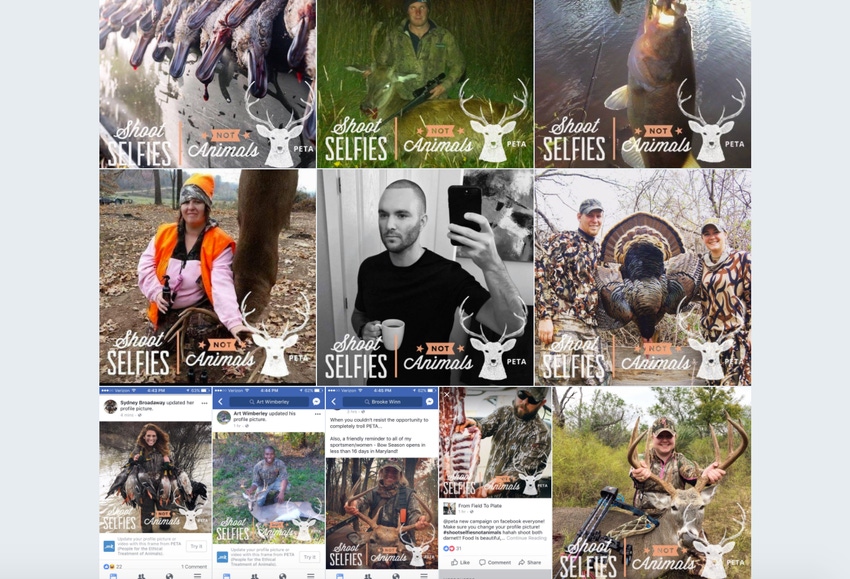Sportsmen take on PETA’s latest campaign. Plus, how do livestock producers effectively share the circle of life story with consumers?
August 28, 2017

I recently read a really captivating article written by Drew French for Medium. Titled, “There is no such thing a vegan,” French offers a very real picture of the circle of life, what exactly is involved for us to be able to consume both plant and animal products, and how his life as a butcher and nature lover has allowed him the unique vantage point of truly understanding what is placed on our dinner plates.
While some of his statements don’t ring entirely true to me namely his paragraph that criticized feedlots, the overall theme was positive and could be incredibly impactful to those who make dietary decisions based on ethical or moral reasons.
Here is an excerpt: “The story I believe in is that respect is the key to eating well — respect for the animals and plants and the Earth, as well as our fellow human beings. When we respect all of these things, and understand the cycles of life and death, only then can we eat authentically and from the heart.
“Even if you consider yourself a vegan, know this: the journey that your beans, grains, or vegetables took to get to your plate involved plenty of suffering and death. Death is an integral part of nature, and we cannot really respect nature until we respect death.”
READ: There is no such thing as a vegan
French’s explanation of the circle of life reminds readers that everything lives (plants and animals alike) and everything dies, and recognizing this circle of life is key to accepting and honoring the vegetation and livestock that had to die in order for us to thrive.
It’s maybe not an easy pill to swallow for some, but for those of us who live and work on farms and ranches, it is part of life. For our urban counterparts who may be shielded from this reality, this is perhaps the hardest story for us to share.
Of course, there are good and bad ways of going about sharing this important circle of life. Recently, a PETA campaign got me thinking about just this topic. Last week, PETA launched a Facebook and Instagram filter that allowed users to frame their profile photos to support the activist organization. The framework read, “Shoot selfies, not animals.”
You may have noticed on social media that sportsmen caught wind of this campaign and decided to do something about it. I saw many hunters posing cheerfully with their game. Photos of fish, pheasants, deer, turkeys — you name it — were framed by the PETA campaign. It appeared like the activist promotion had backfired, but did it really? Maybe, sportsmen responded exactly how PETA was hoping.
Alex Robinson and Natalie Krebs for Outdoor Life probably said it best when they wrote, “First, consider that PETA isn’t trying to convince hunters to stop hunting: The organization is trying to turn non-hunters into anti-hunters. Second, think about all these hero photos from the perspective of a non-hunter.
“Most non-hunters agree with hunting when it’s put in the right context. Logically they understand the conservation benefits and they appreciate the idea of killing wild game for the table. I think many non-hunters can also relate to the traditions behind hunting (spending time with family and friends outside) and the reverence hunters have for wilderness and public land. But non-hunters do not agree with ‘trophy hunting,’ even though most probably do not know what trophy hunting is about. Check out this 2015 poll.
“PETA knows these numbers, too. By flooding Facebook and Instagram with trophy shots, we're putting thousands of dead animal photos in front of non-hunters who are not asking to view them. If we're posting these photos just to troll PETA, we're stripping away the context of the hunt and the whole point of the photo in the first place.
“Most of the ironic posts using the PETA frame have little or no information about the challenge or ethics of the hunt, the beauty of the landscape and habitat, or all the healthy wild meat those dead critters provided. They are mostly just dead animal photos with text that pokes fun at PETA. I don’t think non-hunters are laughing along with us.”
Instead of trolling PETA and perhaps creating enemies of the general public in the process, Robinson and Krebs encouraged sportsmen to create their own Facebook profile frames that include positive slogans such as, “Hunters are conservationists” or “I work hard for my dinner.”
They also encourage folks to share a story with a hunting or fishing photo to add some context to the trip. Stories could talk about the memories made, how many pounds of meat were harvested for your family or a fact about hunting and its benefits on wildlife, habitat and humanity.
To read the entire article and for ideas of facts to share on social media, click here.
Even if you aren’t a sportsman, those of us in animal agriculture can likely relate to this situation. Too often, PETA uses emotion to build a narrative about the livestock industry that isn’t based on sound science or reality. Then we are left to do damage control, all while wondering how PETA gets away with it.
We, just like hunters and fishermen, need to continue to be proactive. Forget trolling PETA. Let’s beat them to the punch by sharing positive stories, beautiful images and personal testimonies from the ranch. The circle of life isn’t always easy to understand, but it’s a story we must tell, so groups like PETA don’t do it for us.
The opinions of Amanda Radke are not necessarily those of beefmagazine.com or Farm Progress.
About the Author(s)
You May Also Like



.png?width=300&auto=webp&quality=80&disable=upscale)
.png?width=300&auto=webp&quality=80&disable=upscale)
